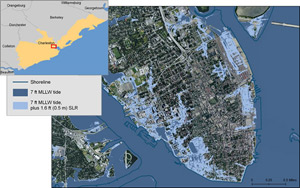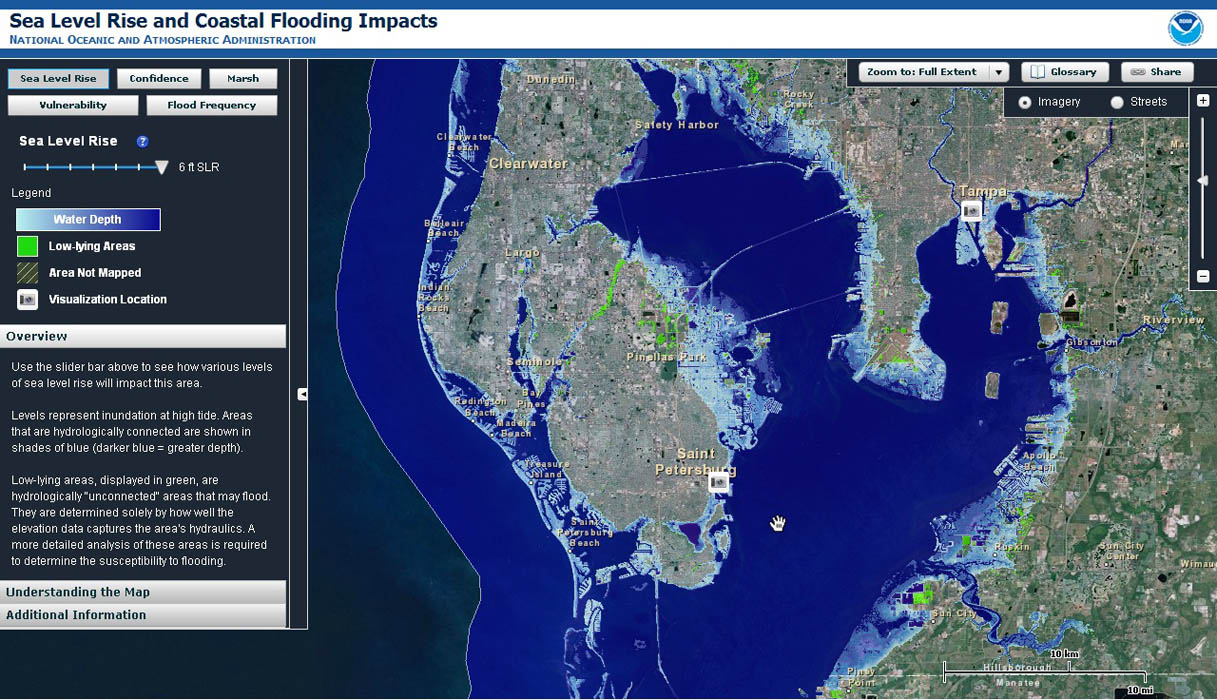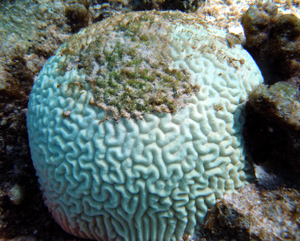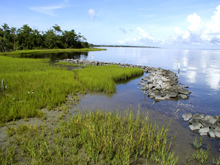Climate Change
Coastal Areas Impacts & Adaptation
Coastal Areas Impacts & Adaptation

Climate Impacts on Coastal Areas
On This Page
Key Points
- Climate change could put additional stress on coastal areas, which are already stressed by human activity, pollution, invasive species, and storms.
- Coastal development reduces the ability of natural systems to respond to climate changes.
- Sea level rise could erode and inundate coastal ecosystems and eliminate wetlands.
- Warmer and more acidic oceans are likely to disrupt coastal and marine ecosystems.
Related Links
EPA:
- Climate Change and Water: Coastal and Ocean Waters
- EPA A Reef Manager's Guide to Coral Bleaching
- EPA Climate Change and Interacting Stressors: Implications for Coral Reef Management in American Samoa
- EPA Climate Ready Estuaries
- EPA Climate Change Science: Sea Level
- EPA Climate Change Science: Ocean Acidity
Other:
- USGCRP Synthesis Assessment Product 4.1, Coastal Sensitivity to Sea-Level Rise: A Focus on the Mid-Atlantic Region
- USGCRP Synthesis Assessment Product 4.4: Preliminary review of adaptation options for climate-sensitive ecosystems and resources (PDF)
-
IPCC Working Group II

- USGCRP, Global Climate Change Impacts in the United States: Coasts Region
-
NRC America's Climate Choices: Adapting to the Impacts of Climate Change

- NOAA: Sea Level Rise and Coastal Flooding Impacts Viewer
- NOAA: Sea Levels Online
- USGS: Sea Level Rise
 View enlarged image
View enlarged image
The National Oceanic and Atmospheric Administration (NOAA) projects that sea level rise will increase flooding in Charleston, South Carolina. Source: NOAA Coastal Services Center (2012)
The coastline of the United States is highly populated. [1] Of the 25 most densely populated U.S. counties, 23 are along a coast. [1] Coastal and ocean activities, such as marine transportation of goods, offshore energy drilling, resource extraction, fish cultivation, recreation, and tourism are integral to the nation's economy. [2] Coastal areas are also home to species and habitats that provide many benefits to society and natural ecosystems.
Climate change could affect coastal areas in a variety of ways. Coasts are sensitive to sea level rise, changes in the frequency and intensity of storms, increases in precipitation, and warmer ocean temperatures. In addition, rising atmospheric concentrations of carbon dioxide (CO2) are causing the oceans to absorb more of the gas and become more acidic. This rising acidity could have significant impacts on coastal and marine ecosystems.
The impacts of climate change are likely to worsen many problems that coastal areas already face. Shoreline erosion, coastal flooding, and water pollution affect man-made infrastructure and coastal ecosystems. Confronting existing challenges is already a concern. Addressing the additional stress of climate change may require new approaches to managing land, water, waste, and ecosystems.
To learn about how natural resource managers are helping coastal areas adapt to climate change, please visit the Coasts Adaptation section.
Impacts of Sea Level Rise
 View enlarged image
View enlarged image
Observed changes in sea level relative to land elevation in the United States between 1958 and 2008. Source: USGCRP (2009)
During the 20th century, global sea level rose by roughly seven inches. [3]
In a particular location, the change in sea level that is observed will be affected by the increase in global sea level as well as land movement up or down. The motion of land can be caused by melting ice or tectonic movement. The terms "local" or "relative" sea level refer to both the global change in sea level and the effects of land motion.
Where the land mass is sinking, relative sea level rise rate is larger than the global rate. Some of the fastest rates of relative sea level rise in the United States are occurring in areas where the land is sinking (or “subsiding”), including parts of the Gulf Coast. For example, coastal Louisiana has seen its relative sea level rise by eight inches or more in the last 50 years, [2] which is slightly faster than twice the global rate. Subsiding land in the Chesapeake Bay area is also projected to worsen the effects of relative sea level rise, increasing the risk of flooding in cities, inhabited islands, and tidal wetlands. [2]
Sea Level Rise and Coastal Flooding Impacts Viewer
The National Oceanic and Atmospheric Administration has developed a tool to visualize the potential impacts of sea level rise on coastal communities. The viewer is currently operational for Mississippi, Alabama, Texas, and Florida, with additional coastal counties to be added in the near future.

NOAA's sea level rise and coastal flooding impacts viewer. Source: NOAA (2012)
Due to differences in land motion, estimates of future relative sea level rise vary for different regions. Climate change models project that global sea level rise will accelerate in the 21st century. Models based on thermal expansion and ice melt estimate that global sea levels will rise approximately 20 to 39 inches by the end of the century. However, due to uncertainties about the response of ice sheets to warmer temperatures and future emissions of greenhouse gases, higher values are possible and cannot be excluded. [4]
For more information on recent and future sea level rise, please visit the Science section.
Sea Level Rise in the Mid-Atlantic Region
In 2009, the U.S. Global Change Research Program produced a report that discussed possible impacts of sea level rise and how governments and communities can respond to rising waters. The report focuses on the mid-Atlantic coast of the United States and found that:
- Rates of relative sea level rise in the mid-Atlantic region were higher than the global average and generally ranged between 0.1 and 0.2 inches per year.
- Many tidal wetlands in the United States are already on the decline, in part from rising sea levels.
- If sea level rises 39 inches (one meter) in the next century, most wetlands will be lost and many narrow barrier islands may disintegrate.
Growing populations and development along the coasts increase the vulnerability of coastal ecosystems to sea level rise. Development can change the amount of sediment delivered to coastal areas, worsen erosion, and remove or damage wetlands. For example, coastal Louisiana lost 1,900 square miles of wetlands in recent decades due to human alterations of the Mississippi River's sediment system and oil and water extraction that has caused land to sink. As a result of these changes, wetlands do not receive enough sediment to keep up with the rising seas and no longer function as natural buffers to flooding. [5]
Rising sea levels could also increase the salinity of ground water and push salt water further upstream. This salinity may make water undrinkable without desalination, and harms aquatic plants and animals that cannot tolerate increased salinity. [3] In the mid-Atlantic region, sea level rise is making estuaries more salty, threatening aquatic plants and animals that are sensitive to salinity. [2]
Impacts of Changes in Storm Surge and Precipitation
Coastal areas are also vulnerable to increases in the intensity of storm surge and heavy precipitation. Storm surges already flood low-lying areas, damage property, disrupt transportation systems, destroy habitat, and threaten human health and safety. Sea level rise could magnify the impacts of storms by raising the water level that storm surges affect. [6] For example, with projected rates in sea level rise, areas of New York City (portions of lower Manhattan and the southwest shores of Brooklyn, Queens, and Staten Island) could be flooded by several feet of water during strong storms. [3] [7]
Climate change will likely bring heavier rainfall and more precipitation to some coastal areas. This could lead to increases in runoff and flooding. In addition, warmer temperatures in mountain areas could lead to more spring runoff due to melting of snow. In turn, increases in spring runoff may also threaten the health and quality of coastal waters. Some coastal areas, such as the Gulf of Mexico and the Chesapeake Bay, are already experiencing "dead zones"--areas where bottom water is depleted of oxygen because of pollution from agricultural fertilizers, delivered by runoff. As increases in spring runoff bring more nitrogen, phosphorus, and other pollutants into coastal waters, many aquatic species could be threatened. [2]
Decreases in precipitation could also affect the salinity of coastal waters. Droughts reduce fresh water input into tidal rivers and bays, which raises salinity in estuaries, and enables salt water to mix farther upstream. [1]
Impacts of Coastal Water Temperature
Coastal waters have warmed during the last century, and are very likely to continue to warm by as much as 4 to 8°F in the 21st century. [2] This warming may lead to big changes in coastal ecosystems, affecting species that inhabit these areas.
Warming coastal waters may cause suitable habitats of temperature-sensitive species to shift northward. Some areas have already seen range shifts in both warm- and cold-water fish and other marine species. Pollock, halibut, rock sole, and snow crab in Alaska and mangrove trees in Florida are a few of the species whose habitats have already begun to shift. [2] [3] Suitable habitats of other species may also shift because they cannot compete for limited resources with the southern species that are moving northward. [2] Invasive species that had not been able to establish populations in colder environments may now be able to survive and start competing with native species. [2]
For more information on climate change impacts on species, visit the Ecosystems page.
Climate Ready Estuaries Program

Estuaries are particularly sensitive to many projected impacts of climate change, including erosion from rising seas, changes in storms frequency and intensity, and the amount of precipitation. EPA's Climate Ready Estuaries program works with National Estuary Programs and other coastal managers to:
- Assess climate change vulnerabilities.
- Engage and educate stakeholders.
- Develop and implement adaptation strategies.
- Share lessons learned with other coastal managers.
The Climate Ready Estuaries website provides resources for estuaries and coastal programs that are interested in learning more about climate change impacts and adaptation.
To learn more about estuaries, visit the EPA Estuaries and Coastal Watersheds web page.
Impacts of Ocean Acidification

Bleached brain coral. Source: NOAA
Higher sea surface temperatures and ocean acidification would increase the risks of coral bleaching events that can lead to loss of critical habitat. [2] The rising concentration of carbon dioxide (CO2) in the atmosphere has increased the absorption of CO2 in the ocean, where a chemical reaction that reduces the pH and makes the oceans more acidic occurs. This trend will likely continue in the coming decades. A more acidic ocean would adversely affect the health of many marine species, including plankton, mollusks, and other shellfish. In particular, corals can be very sensitive to rising acidity, as it is difficult for them to create and maintain the skeletal structures needed for their support and protection. Corals in the Florida Keys, Hawaii, Puerto Rico, and other U.S. territories could be lost if CO2 concentrations in the atmosphere continue to rise at their current rate. [2]
Learn more about how we can adapt to the coastal impacts of climate change.
References
1. CCSP (2009). Coastal Sensitivity to Sea-Level Rise: A Focus on the Mid-Atlantic Region . A Report by the U.S. Climate Change Science Program and the Subcommittee on Global Change Research. Titus, J.G. (Coordinating Lead Author), K.E Anderson, D.R. Cahoon, D.B. Gesch, S.K. Gill, B.T. Gutierrez, E.R. Thieler, and S.J. Williams (Lead Authors). U.S. Environmental Protection Agency, Washington, DC, USA.
2. USGCRP (2009). Global Climate Change Impacts in the United States . Karl, T.R., J.M. Melillo, and T.C. Peterson (eds.). United States Global Change Research Program. Cambridge University Press, New York, NY, USA.
3. Nicholls, R.J., P.P. Wong, V.R. Burkett, J.O. Codignotto, J.E. Hay, R.F. McLean, S. Ragoonaden and C.D. Woodroffe (2007). Coastal systems and low-lying areas. In: Climate
Change 2007: Impacts, Adaptation, and Vulnerability
.
![]() Contribution of Working Group II to the Fourth Assessment Report of the Intergovernmental Panel on Climate Change Parry, M.L., O.F. Canziani, J.P. Palutikof, P.J. van der Linden and C.E. Hanson (eds.). Cambridge University Press, Cambridge, United Kingdom.
Contribution of Working Group II to the Fourth Assessment Report of the Intergovernmental Panel on Climate Change Parry, M.L., O.F. Canziani, J.P. Palutikof, P.J. van der Linden and C.E. Hanson (eds.). Cambridge University Press, Cambridge, United Kingdom.
4. NRC (2011). Climate Stabilization Targets: Emissions, Concentrations, and Impacts over Decades to Millennia . National Research Council. The National Academies Press, Washington, DC, USA.
5. CCSP (2008). Impacts of Climate Change and Variability on Transportation Systems and Infrastructure: Gulf Coast Study, Phase I. A Report by the U.S. Climate Change Science Program and the Subcommittee on Global Change Research. Savonis, M. J., V.R. Burkett, and J.R. Potter (eds.). Department of Transportation, Washington, DC, USA, 445 pp.
6. NRC (2010). Adapting to the Impacts of Climate Change
.
![]() National Research Council. The National Academies Press, Washington, DC, USA.
National Research Council. The National Academies Press, Washington, DC, USA.
7. Field, C.B., L.D. Mortsch, M. Brklacich, D.L. Forbes, P. Kovacs, J.A. Patz, S.W. Running and M.J. Scott (2007). North America. In: Climate Change 2007: Impacts, Adaptation and Vulnerability
.
![]() Contribution of Working Group II to the Fourth Assessment Report of the Intergovernmental Panel on Climate Change. Parry, M.L., O.F. Canziani, J.P. Palutikof, P.J. van der Linden, and C.E. Hanson (eds.). Cambridge University Press, Cambridge, United Kingdom.
Contribution of Working Group II to the Fourth Assessment Report of the Intergovernmental Panel on Climate Change. Parry, M.L., O.F. Canziani, J.P. Palutikof, P.J. van der Linden, and C.E. Hanson (eds.). Cambridge University Press, Cambridge, United Kingdom.

